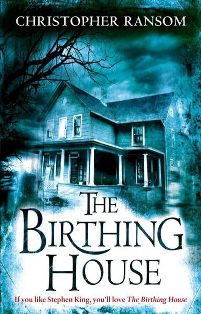
First published back in November of 2008, Christopher Ransom’s debut novel ‘The Birthing House’ was massively publicised with a considerable amount of hype around its release and subsequent reprinting.
DLS Synopsis:
In the quiet and somewhat quaint town of Black Earth, currently unemployed Conrad Harrison purchases an old property in this subdued town in order to start off a new life with his wife Jo. The house Conrad purchases was once a birthing house, which soon begins to reveal an increasingly disturbing supernatural side.
Whilst Conrad’s wife Jo is away for eight long weeks on a training course in L.A., Conrad begins to witness strange occurrences throughout the house. The unsettling wailing of a baby shrieks through the stillness of the night. Unexplained splashes of blood appear on the floor, and the ghostly vision of a woman who looks to be a clone of his wife keeps appearing.
Conrad feels like his sanity is gradually slipping away from him. And as his world starts to fall to pieces, with depression always at his heals, Conrad begins an unhealthy obsession with the next-door-neighbour’s pregnant daughter – Nadia. Whilst his neighbours go away on holiday, Conrad babysits Nadia and their house. His feelings for Nadia quickly grow; his need for a close link with her consuming him. But Nadia has a dark secret. One that involves the house where he lives. One that won’t go away.
History is folding in on itself. Dark memories of the atrocities that were performed within the walls of Conrad’s new house are slowly creeping back. The cycle of life is everywhere. And as Conrad delves deeper into the murky past of the property, everything suddenly gets a whole lot worse. And more dangerous...
DLS Review:
Christopher Ransom’s debut novel is certainly an odd one to get to grips with. Suspense and a lingering tension gradually build throughout the length of the tale. With sudden jolts of nerve-chilling supernatural elements jumping out at almost regular intervals, the tale itself appears to build on a very well time-tested formula for supernatural horror fiction. Indeed, the likes of Jay Anson’s ‘The Amityville Horror’ (1977) are instantly recognisable within the haunted house plot. From here, Ransom really needs to up-the-anti with either the scare factor or a strong twist of real originality. Alas, neither are achieved to any significant level.
Ransom has managed to create a likable and easily identifiable character in Conrad Harrison. His casual lifestyle and slightly shy approach to the world, brings out qualities that most people can identify with in some way or another. His versatile mood swings give the reader an opportunity to feel connected with the character and subsequently sympathise with the strange happenings that are occurring within the house.
With a heavy weight put on both Conrad’s relationships (with both his wife and the developing one with Nadia from next-door), the book tentatively explores multiple emotional paths, which in turn allows Ransom to flesh-out and expand upon the base human reactions to the growing dilemma. Furthermore, the confusing nature behind Conrad's feelings towards his wife, Nadia and even his ex-girlfriend, leaves an unsettled undertone running alongside the main supernatural thrust of the tale. This ambiguity with Conrad’s true feelings subtly puts the reader off guard, with odd moments of doubt scattered throughout the tale that leaves the reader questioning almost every one of the principal character’s motivations and perhaps even his sanity.
The novel falls foul of clumsiness on so many occasions it becomes quite off-putting. The slightly abstract prose that Ransom has adopted, whether purposely or not, hinders the progression of the storyline rather than anything else. This repeatedly results in moments of unnecessary confusion for the reader, throwing them out of the storyline in one fell swoop. Coupled with a growing feeling of frustration at the author’s overly-clumsy writing style, the twists and turns in the plot more often than not miss their mark, resulting in low impact and unforgiveable groans at the clichéd haunting.
The sexual elements are infrequent yet memorable in their sudden intensity. Ransom has not limited himself with this debut novel by purposefully (or somewhat bashfully) holding back on these elements, but instead he has embraced the importance of the acts within the developing storyline, allowing them to flesh out the characters more, along with expanding on the fundamental ‘birth, sex, death’ elements of the haunting.
The novel ends on a vague and very suggestive note, putting the onus on the reader to take from the explanation what they will. Although this undoubtedly has its own merits, so many unresolved loose threads are left dangling, veering further towards the lazy and unaccomplished than thought provoking.
What really sets the novel back is the number of moments that are just plain old more clichéd than creepy. Ransom pulls no new tricks out of the hat, but instead bundles along with now overly-familiar horror scenes. The few brief sparks of originality within the tale are taken no further, leaving the novel as a mediocre read at best.
All in all, ‘The Birthing House’ delivers a lukewarm horror story with some well-developed characters and intriguingly meandering subplots. These elements are the only saving grace for an otherwise unoriginal, uninspired, clumsily written and poorly concluded novel.
The novel runs for a total of 407 pages.
© DLS Reviews






